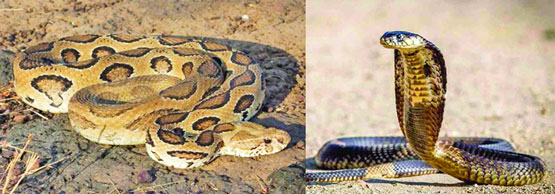Why has snake activity suddenly increased in Bangladesh?
Special Correspondent: Bangladesh is home to a diverse array of snakes, with estimates ranging from 80 to over 100 species. These species are distributed across different regions based on geographical and environmental conditions. Recently, there has been a noticeable rise in sightings of venomous snakes, particularly Russell’s vipers, across the country, causing widespread concern.
Zoologists attribute this increase to a significant decline in the populations of natural predators such as kites and mongooses. These predators play a crucial role in controlling snake populations. When their numbers dwindle, the snake population is likely to surge.
Data from the Venom Research Center of Bangladesh’s health department indicates that approximately 403,000 people and 2,500 cattle fall victim to snake bites each year, with 7,511 human fatalities. The primary cause of death is the lack of timely medical treatment, especially in rural areas where healthcare facilities are scarce.
To address this, the Bangladesh government and various NGOs are working to raise awareness about snake bite treatment and ensure proper medical care. Prompt administration of antivenom can save lives, but alarmingly, about 25% of all snake bites involve venomous species. While many victims recover, they often face long-term physical and mental health issues.
Bangladesh hosts both venomous and non-venomous snakes. Venomous species include the king cobra, common cobra, Russell’s viper, common krait, banded krait, saw-scaled viper, and green pit viper. Non-venomous species, such as the Indian python, rat snake, red sand boa, green water snake, chicken snake, and flying snake, also inhabit the country.
Experts emphasize that urbanization, deforestation, and agricultural expansion are disrupting natural ecosystems, adversely affecting the balance of snake populations. Conservation of snakes and their natural predators is essential, as snakes act as natural insecticides and help maintain environmental balance.
Snakes have numerous natural enemies, including mongooses, kites, hawks, eagles, owls, wild cats, and larger frogs. However, these animals are being killed indiscriminately, disrupting the ecosystem and leading to an increase in snake numbers.
Mongooses are renowned for their ability to hunt venomous snakes like cobras and vipers. While they can neutralize small amounts of snake venom due to glycoproteins in their bodies, they are not immune to large doses. Mongooses are vital in controlling snake populations and also prey on rats and other pests.
Birds of prey like kites, hawks, and owls are adept at hunting snakes but have decreased significantly in number. Monitor lizards, another predator, are also less common. The absence of these animals has allowed snake populations to thrive.
Mahfuzur Rahman, president of Deep Ecology and Snake Conservation Foundation, highlights the issue of people killing non-venomous and beneficial snakes out of fear. He stresses the importance of educating the public about the ecological benefits of snakes and other predators.
Professor Md. Nadiruzzaman Mandal of Dhaka University’s Department of Soil, Water, and Environment underscores the importance of maintaining the food chain for ecological balance. He warns that disrupting this balance, as seen with the increase in snake and rat populations, can lead to conflicts with humans.
Professor Mohammad Feroz Zaman of Dhaka University’s Zoology Department explains that habitat destruction and climate change are forcing snakes into human settlements. The removal of predators and the alteration of natural habitats are contributing to the increase in snake sightings.
Raising public awareness and conserving predator species are crucial steps to restoring ecological balance. The state has a responsibility to educate the public and take measures to protect wildlife. With increased awareness and proactive measures, a stable ecological balance can be achieved in the coming years. If not, the environment faces severe disruption.
In conclusion, addressing the sudden increase in snake activity requires a multifaceted approach involving conservation, public education, and habitat protection. Only by restoring the natural balance can the snake nuisance be effectively managed.
Rare Israeli airstrike in Beirut kills Hezbollah commander and more than a dozen others
International Desk: Israel launched a rare airstrike that killed a senior Hezbollah milita…








